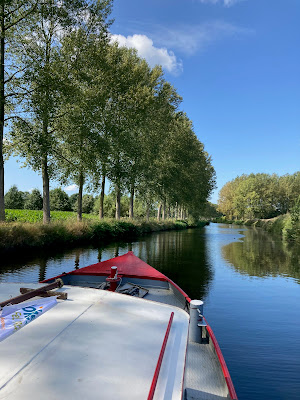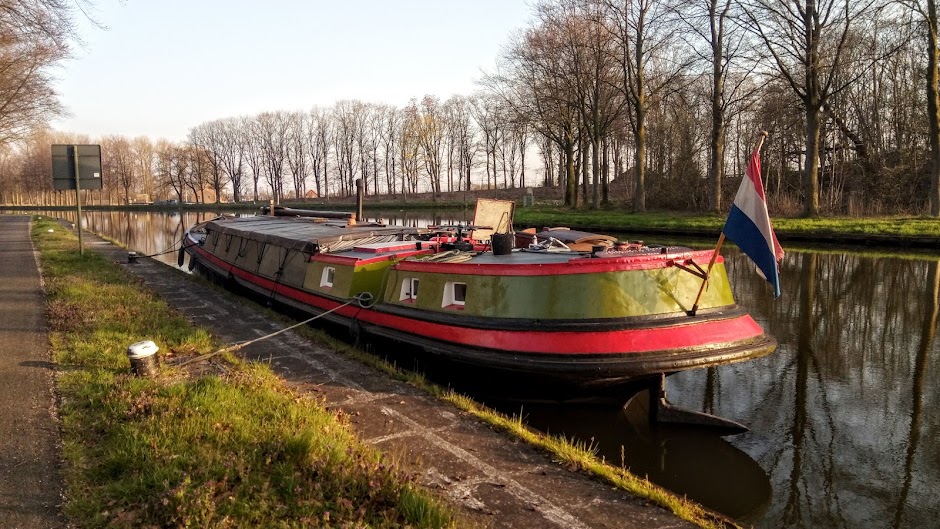At last, I can hear you thinking. This is the final post of our summer travels. It's just as well I've got my journal and photos as now autumn is well and truly with us the memories of those wonderful weeks in August are beginning to dim, or if not that, at least feel a little unreal.
It was Thursday, the 22nd of August when we left Ghent and headed out onto the canal to Terneuzen. As we left, we passed the Tolhuis Lock, which always seems to be closed, and I've never met anyone who's been through it.
"Wouldn't it have been great if we could have come through that way?" I said, musing on why it was never open and why too there was no information about it in our guide book.
"I don't know why it's not in use," Koos replied. "It would make a great short cut through for us."
Our mooring on the Brugsevaart two days previously was just around the corner from the canal leading to the Tolhuis Lock. As chance would have it, I've discovered since we came home that we can actually go through it now. I'll just have to go to this
website to find out what days and times it's operating as it's apparently not available every day.
 |
| The Tolhuis Lock |
Anyway, we continued on our way, and the two photos below show the very low bridge I can never quite believe we manage to pass under without crunching into it. We could ask for it to be lifted, but, as Koos says, where's the fun in that? Once we're through it, though, we can head north without interruption; that is, unless we're going into the Moervaart, which this time we did.
 |
| That is one very low bridge |
 |
| But we got under it without incident...phew! |
 |
I love this old power station. It reminds me
a little of Battersea in London |
 |
| Meanwhile, Zoe snoozed |
The turning onto the Moervaat leading to the town of Lokeren is around 6 km or 45 mins by boat from the outskirts of Ghent. The contrast between the bustling industry and busy shipping of the canal to Terneuzen and the sleepy Moervaart is quite a shock. Within a few hundred metres of the cooling tower that marks the entrance to the waterway, the factories and loading quays of Ghent’s docklands have disappeared and the farer is suddenly in deepest, rural Belgium.
Koos and I both agree it is one of the most beautiful waterways in the country, and maybe even in the whole region. It really is breathtakingly lovely, an impression emphasised by such rural scenes as these cows in the photo below sloshing around in the shallows.
 |
Cows enjoy a cooling paddle as much as
people |
After seven kilometres of peaceful cruising, we had to start a
blokvaart. You may remember this from the last post. It's when we have to be at the first of a series of bridges at a specific time and then we can go through all the subsequent bridges in the series. On the Moervaart, there are seven and it takes about two and a half hours to complete them all.
Below are just some of the scenes we saw on route. Our bridge keeper was very efficient and kept us moving, although he was very friendly and it was a pleasure to see him getting ready for us as we approached each of the bridges. They're all delightfully old-fashioned, so it was a wonderful trip.
 |
A beautiful lifting bridge for a former railway
It was built between the two great wars |
 |
And a nearby historic watertower form the
19th century |
We arrived in Lokeren at the end of navigation late in the afternoon, but by this time we were on the river Durme. The Moervaart and the Durme join forces a few kilometres north of town near the village of Daknam and from that point on the river into Lokeren becomes extremely winding and wild.
It was the end of a beautiful, sunny day as well, but Koos was tired and finding a free spot in the marina provided more challenge than either of us wanted. We'd gone up to the end and finding nowhere to moor up, it was a question of reversing a long way back to where we'd seen a place with just enough room.
With the Hennie H's fickleness and no bow thruster to help, the task took much longer and much more effort than we deserved. In the end patience prevailed and with a few squeaks and several gasps from me when we just avoided hitting a couple of small, expensive boats, we were in.
.jpeg) |
| Our mooring |
 |
| Numerous small boats to dodge |
 |
| But a nice pontoon with electricity, water and wifi |
.jpeg) |
| The view from the entrance to the marina |
Lokeren is an attractive town. Not only does it have a lovely centre with some fine old buildings, but everything is close at hand: shops, dog walking woods and plenty of cafés, museums and sights for the visitor. We really liked it so much we decided to stay a few days. The marina is also very reasonably priced, but since you really have to want to go there (the river being quite challenging), I suppose they make it as appealing as possible.
.jpeg) |
| The town hall (stadhuis) |
.jpeg) |
| Not sure what this was, but it's lovely. |
 |
One day was a bit grey, but this is the main
shopping street |
 |
| The end of the Durme |
The photo above is where the river Durme was dammed in the town. The marina is on the other side of this basin. There's another dam further downstream towards the confluence with the Schelde. Why was it cut off, you might ask. Well, according to the museum, the navigation was closed as there was no longer a need for barges to reach Lokeren, but other information says that constant flooding became a burden in Lokeren, so I'm guessing the lack of commercial traffic gave them the excuse they needed to keep the tidal river out of harm's way.
Lokeren also has an interesting history which was explained more at the museum. Apparently it used to be the centre of the hare plucking industry. Yes, that is hare and not hair. It seems that hare and rabbit fur was used for making felt and cutting the hares' hair was big business in this small town. I didn’t want to dwell on how the poor creatures suffered during this process but was thankful the practice of hanging them upside down is no more.
In fact, we very much enjoyed our few days of rest which included a visit to the Sunday morning bric-a-brac market as well as the museum. As we know, though, all good things come to an end, and on Monday the 26th August, we left bright and early at 8:00 a.m. This time we just had to reverse a short distance to be able to turn around and head back to the first bridge for our return blokvaart.
 |
Zelzate bridge: the last town and bridge
in Belgium |
 |
| Just a kilometre beyond it and we were home |
So that's it,
allemaal. I've managed to finish this series of blogs about our barging holiday in Belgium. I shall read these back later in the year and probably think nostalgically of those wonderful warm days. I hope you've enjoyed reading them as much as I've enjoyed reliving the experiences.
Enjoy the rest of your week, anyway, and I'll be back with a catch up of the weeks since our return very soon.








.jpeg)


.jpeg)
.jpeg)
.jpeg)















And now the book! What a lovely blog, Val. And such beautiful photos. What delightful places you visited. I've really enjoyed faring with you all this summer. Such a bonus that Zoe enjoys it, too.
ReplyDeleteThank you, dear Chris. With the nudge about the book, I would have known it was you. 😆 I promise I’ll work on that. 💚
DeleteDid not mean to be anonymous, Val. It's me, Chris Moore xxxx
ReplyDeleteIt was the ‘And now the book’ that told me, my friend. Thank you for reading it and staying with me. 💚
DeleteWhat an enjoyable read, and how beautiful is Belgium. Love the paddling cows, the old water tower, and the mooring with water and wifi, very modern. The bridge keeper sounds most obliging, as well as very necessary. Lovely post Val.
ReplyDeleteThank you, Trish. I'm very pleased you enjoyed the journey. Belgium is lovely off the beaten track, that's true! Keep well! xx
DeleteI really enjoyed reading about this trip and the photo's have been lovely too. The architecture is ornate and I particularly liked the power station & tha water tower.
ReplyDeleteTake care, David.
Ah, thank you, David. The architecture is indeed ornate, and typical of Flanders. I'm glad you liked the power station. I am very fond of that building.
DeleteThanks for the vaart Val! Really enjoyed this trip 😎
ReplyDeleteYou are most welcome. I'm glad you enjoyed it and thank you for reading and commenting.
DeleteWhat a marvelous adventure! I think I would have uttered quite a few squeaks as Koos squeaked into tight places beside expensive boats! Lovely, lovely photos - and it's wonderful that sweet Zoe is a good traveler! She looks so comfy in her barge bed! And blue sky...it was indeed a blessed trip and y'all totally deserved it. (steph)
ReplyDeleteAh, thank you so much, Steph. I know how you long for the sunshine and warmth. It seems like a distant memory to me now too, as our weather is also wet and cold. But, we were so very blessed with all that wonderful warmth. It was a great adventure, as you say!
DeleteHello Val. I love the old-fashioned bridges. We have those here in Chicago which they open at the end of summer to allow boat-owners to store their boats for the winter. I also like the red plants outside the town hall and again your great photography gave me a chance to ride along. Lastly, poor hares!
ReplyDeleteThank you, Lynn. I'd love to see those old Chicago bridges too. It must be lovely to watch them opening. I'm glad you enjoyed the photos. I like sharing the context, but yes, those poor hares. There's an image of one hanging upside down on the museum wall. A little shocking for me.
DeleteWhat a serene journey (bar trying to moor up in that tight space). Loved the cows paddling. Loved the old buildings, the chemist one in particular. Always fun to fare vicariously along with you!
ReplyDeleteAh thank you, Shirley. I'm delighted you enjoyed faring vicariously with us.
Delete